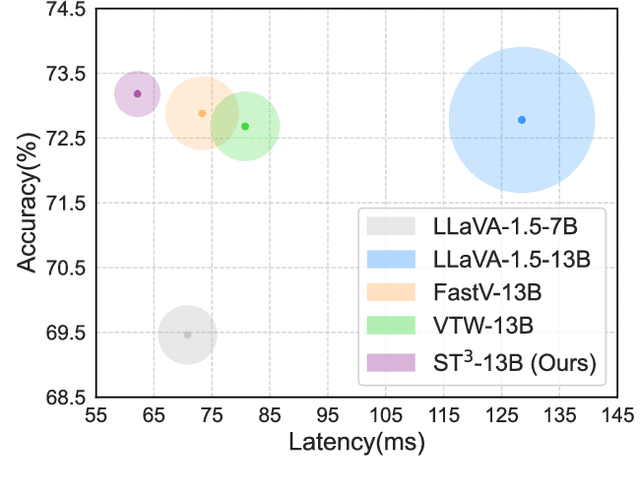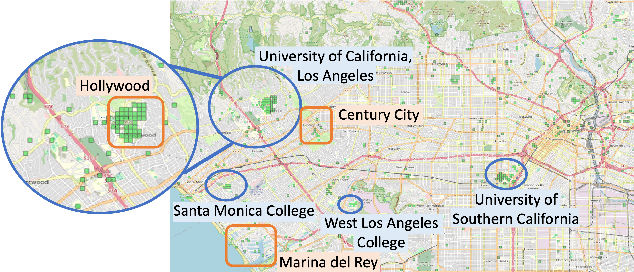Haoji Hu
No Pixel Left Behind: A Detail-Preserving Architecture for Robust High-Resolution AI-Generated Image Detection
Aug 24, 2025Abstract:The rapid growth of high-resolution, meticulously crafted AI-generated images poses a significant challenge to existing detection methods, which are often trained and evaluated on low-resolution, automatically generated datasets that do not align with the complexities of high-resolution scenarios. A common practice is to resize or center-crop high-resolution images to fit standard network inputs. However, without full coverage of all pixels, such strategies risk either obscuring subtle, high-frequency artifacts or discarding information from uncovered regions, leading to input information loss. In this paper, we introduce the High-Resolution Detail-Aggregation Network (HiDA-Net), a novel framework that ensures no pixel is left behind. We use the Feature Aggregation Module (FAM), which fuses features from multiple full-resolution local tiles with a down-sampled global view of the image. These local features are aggregated and fused with global representations for final prediction, ensuring that native-resolution details are preserved and utilized for detection. To enhance robustness against challenges such as localized AI manipulations and compression, we introduce Token-wise Forgery Localization (TFL) module for fine-grained spatial sensitivity and JPEG Quality Factor Estimation (QFE) module to disentangle generative artifacts from compression noise explicitly. Furthermore, to facilitate future research, we introduce HiRes-50K, a new challenging benchmark consisting of 50,568 images with up to 64 megapixels. Extensive experiments show that HiDA-Net achieves state-of-the-art, increasing accuracy by over 13% on the challenging Chameleon dataset and 10% on our HiRes-50K.
Orientation Matters: Making 3D Generative Models Orientation-Aligned
Jun 10, 2025Abstract:Humans intuitively perceive object shape and orientation from a single image, guided by strong priors about canonical poses. However, existing 3D generative models often produce misaligned results due to inconsistent training data, limiting their usability in downstream tasks. To address this gap, we introduce the task of orientation-aligned 3D object generation: producing 3D objects from single images with consistent orientations across categories. To facilitate this, we construct Objaverse-OA, a dataset of 14,832 orientation-aligned 3D models spanning 1,008 categories. Leveraging Objaverse-OA, we fine-tune two representative 3D generative models based on multi-view diffusion and 3D variational autoencoder frameworks to produce aligned objects that generalize well to unseen objects across various categories. Experimental results demonstrate the superiority of our method over post-hoc alignment approaches. Furthermore, we showcase downstream applications enabled by our aligned object generation, including zero-shot object orientation estimation via analysis-by-synthesis and efficient arrow-based object rotation manipulation.
ReCamMaster: Camera-Controlled Generative Rendering from A Single Video
Mar 14, 2025Abstract:Camera control has been actively studied in text or image conditioned video generation tasks. However, altering camera trajectories of a given video remains under-explored, despite its importance in the field of video creation. It is non-trivial due to the extra constraints of maintaining multiple-frame appearance and dynamic synchronization. To address this, we present ReCamMaster, a camera-controlled generative video re-rendering framework that reproduces the dynamic scene of an input video at novel camera trajectories. The core innovation lies in harnessing the generative capabilities of pre-trained text-to-video models through a simple yet powerful video conditioning mechanism -- its capability often overlooked in current research. To overcome the scarcity of qualified training data, we construct a comprehensive multi-camera synchronized video dataset using Unreal Engine 5, which is carefully curated to follow real-world filming characteristics, covering diverse scenes and camera movements. It helps the model generalize to in-the-wild videos. Lastly, we further improve the robustness to diverse inputs through a meticulously designed training strategy. Extensive experiments tell that our method substantially outperforms existing state-of-the-art approaches and strong baselines. Our method also finds promising applications in video stabilization, super-resolution, and outpainting. Project page: https://jianhongbai.github.io/ReCamMaster/
Dynamic Token Reduction during Generation for Vision Language Models
Jan 24, 2025Abstract:Vision-Language Models (VLMs) have achieved notable success in multimodal tasks but face practical limitations due to the quadratic complexity of decoder attention mechanisms and autoregressive generation. Existing methods like FASTV and VTW have achieved notable results in reducing redundant visual tokens, but these approaches focus on pruning tokens in a single forward pass without systematically analyzing the redundancy of visual tokens throughout the entire generation process. In this paper, we introduce a dynamic pruning strategy tailored for VLMs, namedDynamic Rate (DyRate), which progressively adjusts the compression rate during generation. Our analysis of the distribution of attention reveals that the importance of visual tokens decreases throughout the generation process, inspiring us to adopt a more aggressive compression rate. By integrating a lightweight predictor based on attention distribution, our approach enables flexible adjustment of pruning rates based on the attention distribution. Our experimental results demonstrate that our method not only reduces computational demands but also maintains the quality of responses.
ST$^3$: Accelerating Multimodal Large Language Model by Spatial-Temporal Visual Token Trimming
Dec 28, 2024



Abstract:Multimodal large language models (MLLMs) enhance their perceptual capabilities by integrating visual and textual information. However, processing the massive number of visual tokens incurs a significant computational cost. Existing analysis of the MLLM attention mechanisms remains shallow, leading to coarse-grain token pruning strategies that fail to effectively balance speed and accuracy. In this paper, we conduct a comprehensive investigation of MLLM attention mechanisms with LLaVA. We find that numerous visual tokens and partial attention computations are redundant during the decoding process. Based on this insight, we propose Spatial-Temporal Visual Token Trimming ($\textbf{ST}^{3}$), a framework designed to accelerate MLLM inference without retraining. $\textbf{ST}^{3}$ consists of two primary components: 1) Progressive Visual Token Pruning (\textbf{PVTP}), which eliminates inattentive visual tokens across layers, and 2) Visual Token Annealing (\textbf{VTA}), which dynamically reduces the number of visual tokens in each layer as the generated tokens grow. Together, these techniques deliver around $\mathbf{2\times}$ faster inference with only about $\mathbf{30\%}$ KV cache memory compared to the original LLaVA, while maintaining consistent performance across various datasets. Crucially, $\textbf{ST}^{3}$ can be seamlessly integrated into existing pre-trained MLLMs, providing a plug-and-play solution for efficient inference.
Enhancing Facial Consistency in Conditional Video Generation via Facial Landmark Transformation
Dec 12, 2024

Abstract:Landmark-guided character animation generation is an important field. Generating character animations with facial features consistent with a reference image remains a significant challenge in conditional video generation, especially involving complex motions like dancing. Existing methods often fail to maintain facial feature consistency due to mismatches between the facial landmarks extracted from source videos and the target facial features in the reference image. To address this problem, we propose a facial landmark transformation method based on the 3D Morphable Model (3DMM). We obtain transformed landmarks that align with the target facial features by reconstructing 3D faces from the source landmarks and adjusting the 3DMM parameters to match the reference image. Our method improves the facial consistency between the generated videos and the reference images, effectively improving the facial feature mismatch problem.
SynCamMaster: Synchronizing Multi-Camera Video Generation from Diverse Viewpoints
Dec 10, 2024



Abstract:Recent advancements in video diffusion models have shown exceptional abilities in simulating real-world dynamics and maintaining 3D consistency. This progress inspires us to investigate the potential of these models to ensure dynamic consistency across various viewpoints, a highly desirable feature for applications such as virtual filming. Unlike existing methods focused on multi-view generation of single objects for 4D reconstruction, our interest lies in generating open-world videos from arbitrary viewpoints, incorporating 6 DoF camera poses. To achieve this, we propose a plug-and-play module that enhances a pre-trained text-to-video model for multi-camera video generation, ensuring consistent content across different viewpoints. Specifically, we introduce a multi-view synchronization module to maintain appearance and geometry consistency across these viewpoints. Given the scarcity of high-quality training data, we design a hybrid training scheme that leverages multi-camera images and monocular videos to supplement Unreal Engine-rendered multi-camera videos. Furthermore, our method enables intriguing extensions, such as re-rendering a video from novel viewpoints. We also release a multi-view synchronized video dataset, named SynCamVideo-Dataset. Project page: https://jianhongbai.github.io/SynCamMaster/.
UrbanCAD: Towards Highly Controllable and Photorealistic 3D Vehicles for Urban Scene Simulation
Nov 28, 2024Abstract:Photorealistic 3D vehicle models with high controllability are essential for autonomous driving simulation and data augmentation. While handcrafted CAD models provide flexible controllability, free CAD libraries often lack the high-quality materials necessary for photorealistic rendering. Conversely, reconstructed 3D models offer high-fidelity rendering but lack controllability. In this work, we introduce UrbanCAD, a framework that pushes the frontier of the photorealism-controllability trade-off by generating highly controllable and photorealistic 3D vehicle digital twins from a single urban image and a collection of free 3D CAD models and handcrafted materials. These digital twins enable realistic 360-degree rendering, vehicle insertion, material transfer, relighting, and component manipulation such as opening doors and rolling down windows, supporting the construction of long-tail scenarios. To achieve this, we propose a novel pipeline that operates in a retrieval-optimization manner, adapting to observational data while preserving flexible controllability and fine-grained handcrafted details. Furthermore, given multi-view background perspective and fisheye images, we approximate environment lighting using fisheye images and reconstruct the background with 3DGS, enabling the photorealistic insertion of optimized CAD models into rendered novel view backgrounds. Experimental results demonstrate that UrbanCAD outperforms baselines based on reconstruction and retrieval in terms of photorealism. Additionally, we show that various perception models maintain their accuracy when evaluated on UrbanCAD with in-distribution configurations but degrade when applied to realistic out-of-distribution data generated by our method. This suggests that UrbanCAD is a significant advancement in creating photorealistic, safety-critical driving scenarios for downstream applications.
Context-Aware Trajectory Anomaly Detection
Oct 24, 2024



Abstract:Trajectory anomaly detection is crucial for effective decision-making in urban and human mobility management. Existing methods of trajectory anomaly detection generally focus on training a trajectory generative model and evaluating the likelihood of reconstructing a given trajectory. However, previous work often lacks important contextual information on the trajectory, such as the agent's information (e.g., agent ID) or geographic information (e.g., Points of Interest (POI)), which could provide additional information on accurately capturing anomalous behaviors. To fill this gap, we propose a context-aware anomaly detection approach that models contextual information related to trajectories. The proposed method is based on a trajectory reconstruction framework guided by contextual factors such as agent ID and contextual POI embedding. The injection of contextual information aims to improve the performance of anomaly detection. We conducted experiments in two cities and demonstrated that the proposed approach significantly outperformed existing methods by effectively modeling contextual information. Overall, this paper paves a new direction for advancing trajectory anomaly detection.
FALIP: Visual Prompt as Foveal Attention Boosts CLIP Zero-Shot Performance
Jul 08, 2024



Abstract:CLIP has achieved impressive zero-shot performance after pre-training on a large-scale dataset consisting of paired image-text data. Previous works have utilized CLIP by incorporating manually designed visual prompts like colored circles and blur masks into the images to guide the model's attention, showing enhanced zero-shot performance in downstream tasks. Although these methods have achieved promising results, they inevitably alter the original information of the images, which can lead to failure in specific tasks. We propose a train-free method Foveal-Attention CLIP (FALIP), which adjusts the CLIP's attention by inserting foveal attention masks into the multi-head self-attention module. We demonstrate FALIP effectively boosts CLIP zero-shot performance in tasks such as referring expressions comprehension, image classification, and 3D point cloud recognition. Experimental results further show that FALIP outperforms existing methods on most metrics and can augment current methods to enhance their performance.
 Add to Chrome
Add to Chrome Add to Firefox
Add to Firefox Add to Edge
Add to Edge